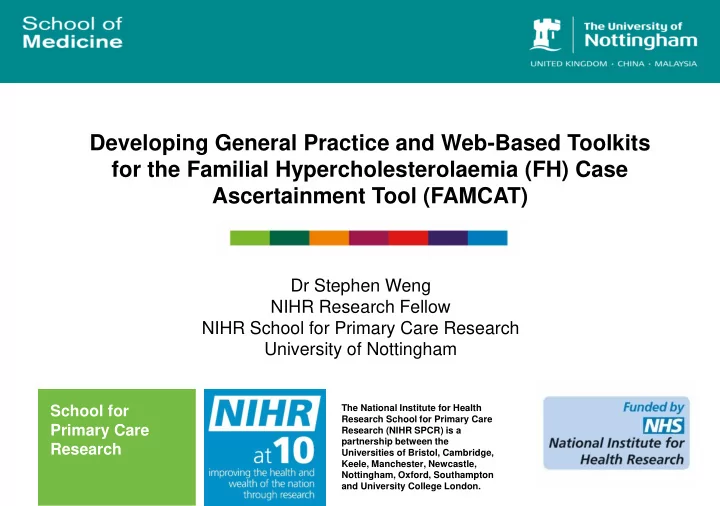

Developing General Practice and Web-Based Toolkits for the Familial Hypercholesterolaemia (FH) Case Ascertainment Tool (FAMCAT) Dr Stephen Weng NIHR Research Fellow NIHR School for Primary Care Research University of Nottingham School for The National Institute for Health Research School for Primary Care Primary Care Research (NIHR SPCR) is a partnership between the Research Universities of Bristol, Cambridge, Keele, Manchester, Newcastle, Nottingham, Oxford, Southampton and University College London.
What is FH? • Inherited autosomal dominant disease ( PCSK9, APOB, Substantial LDLR ) increase in premature CHD • Low density lipoprotein (LDL) cholesterol in higher than risk normal from birth • No cure but there is effective management and treatment How common is FH? 120,000 to • Frequency from 1/500 to 1/200 320,000 • Similar frequency to juvenile onset diabetes affected in the UK How is FH treated? • Referral to specialist secondary care services 50% reduction in LDL-C & 37% • High intensity statins reduction in • Lifestyle modification CHD mortality
FH – natural history ♂ ♀ Age (years) % CHD % CHD <30 5 0 30-39 22 2 40-49 48 7 50-59 80 51 60-69 100 75 Slack J. Risks of ischaemic heart-disease in familial hyperlipoproteinaemic states. The Lancet 1969; 294 (7635): 1380-2.
Familial Hypercholesterolaemia Case Ascertainment Tool • Clinical Practice Research Datalink (CPRD) – 2.9 million patients with cholesterol recorded (including 5050 confirmed FH cases) • Developed risk Prediction Algorithm determines probability a patient has FH • Nine diagnostic indicators (including cholesterol, family history, secondary causes, age, gender, triglycerides, statins prescribing) AUC c-statistic MODEL COMPARISONS (95% Confidence Interval) Primary Analysis 0.556 (0.527 – 0.587) Model 1: TC > 7.5 mmol/L or LDL cholesterol > 4.9 mmol/L 0.749 (0.735 – 0.763) 1 Model 2: NICE/Simon-Broome Criteria 0.737 (0.723 – 0.752) 2 Model 3: Dutch Lipid Clinic Criteria 0.860 (0.848 – 0.871) Model 4: FAMCAT Weng SF, Kai J, Andrew Neil H, Humphries SE, Qureshi N. Improving identification of familial hypercholesterolaemia in primary care: Derivation and validation of the familial hypercholesterolaemia case ascertainment tool (FAMCAT). Atherosclerosis 2015; 238(2): 336-43.
Translation of FAMCAT to UK General Practice: FH Case-Finder Requirements: • Direct extraction of General Practice patient data based on NHS Read Codes/SNOMED CT • Algorithm ranking of probability of FH from most probable to least probable • Mail-merge from patient level data • Auditing feature for feedback to GPs on patients assessed and screened • Display family history recording • Display prescribing of statins
CHART Summary Sheet
Patient Level Data: Named (Identifiable version at practice); Pseudo-anonymised for researchers/CCGs
Pilot Data Extraction from Four General Practices Adults > 16 Adults > 16 years & High Practice Total Patients years TC/LDL Recorded Probability FH 1 (East Midlands) 8,499 6,587 3,009 154 2 (East Midlands) 5,965 4,829 2,268 113 3 (East Midlands) 12,885 10,710 6,222 237 4 (North London) 6,581 5,526 3,082 271 Total 33,930 27,652 14,581 775 Proportion of GP Population Requires Assessment: 775/33,930 = 2.3% Ranking system in tool will prioritise patients with highest probability of FH
In Development: Mobile Application
To Summarise: • Shown that FAMCAT can accurate predict FH better than previous diagnostic criteria • Developed an implementation to practice pathway and toolkit for general practice • Developed web-based tool for non-UK audiences • Successfully extracted data using the toolkit in four practices (3 East Midlands, 1 North London) Going Forward: • Assess the clinical utility of the FAMCAT prospectively in multi-centre study • Assess diagnostic accuracy using a gold standard genetic diagnosis: next generation sequencing • Full trial against usual care: cluster RCT design • Full economic evaluation of FAMCAT to determine cost-effectiveness
Acknowledgements: Professors Nadeem Qureshi & Joe Kai Division of Primary Care University of Nottingham Professor Steve Humphries Centre for Cardiovascular Genetics University College London Professor Andrew Neil Centre for Diabetes, Endocrinology & Metabolism University of Oxford Dr Jon Robinson, Ms Miriam Lemar, Ms Barbara Heyes, & Mr Tim Morell PRIMIS Ltd. Interested in FH? Contact University of Nottingham FAMCAT Study Team Professor Heather Wharrad & Mr Mike Taylor stephen.weng@nottingham.ac.uk Health and E-Learning Media Team University of Nottingham This project was funded by the Nottingham CCG Programme Grant School for Development Award and supported by the School for Primary Care Research. The views expressed are those of the author(s) and not Primary Care necessarily those of the CCG, NHS, the NIHR or the Department of Research Health.
Recommend
More recommend